|

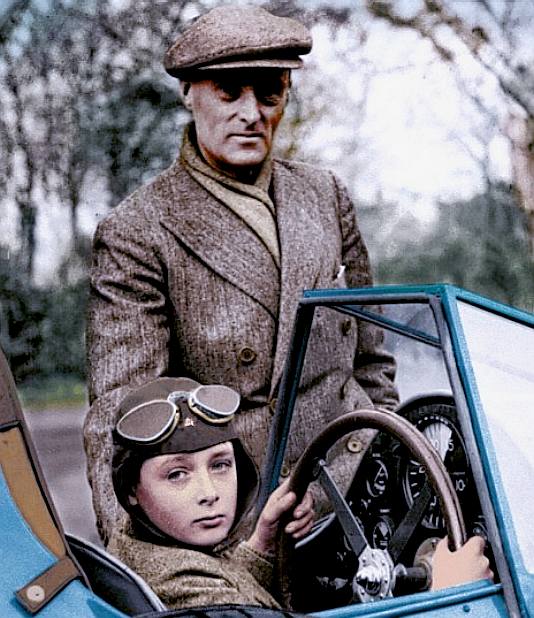
Donald Campbell - cigar in hand playing cards. The dreadful moment when Donald Campbell lost his life is something which an entire generation of people will never
forget. Onlookers gathered at Coniston Water on the calm and cold January day in the hope of watching a successful record attempt.
Campbell's first run averaged 297.6mph. On the return, however, he peaked at 328mph.
Dramatic video footage captured the moment when the boat lifted out of the water like an
airplane, flipped over and smashed into the water at 183mph. Campbell was killed instantly.
he was driven by the shadow of his father and often spoke of this.
It
was just going to be another dash across
the lake, but it changed British water speed record history forever and
raised many questions as to how and why the speed king died. In 1988 DC's
life story was portrayed by actor, Anthony
Hopkins, a splendid BBC production that we hope to one day see on Bluray.
DAILY
MAIL - WAS DONALD CAMPBELL DRIVEN BY A TERRIFYING DEATH WISH? 1 July 2011
He was rejected by the daredevil father who inspired him. Now, for the first time, the family of the Bluebird speed legend reveal his
torment.
When Donald Campbell climbed into the cockpit of his iconic jet boat Bluebird K7 on 4 January 1967, his mind was focused on one thing: a need to prove himself worthy of his heroic father, Sir Malcolm, who held nine land and four water speed records.
Donald had already broken several records and had no need to establish his credentials, but he was driven by a promise he made after Sir Malcolm’s death in 1948 – that he’d step into his father’s shoes, even though at the time he’d never raced before.
Sir Malcolm always doubted whether his son was of the right calibre. Pointedly, he didn’t leave him his Blue Birds in his will; Donald had to buy them from his trustees. Fast-forward to that fateful morning on Coniston Water in the Lake District when, as the world watched, Donald’s attempt to break the 300mph speed barrier ended in tragedy.
Seconds from reaching record speed, the boat somersaulted before smashing into the concrete-hard surface. It would be 34 years before his body, and Bluebird, were recovered.
But how did it happen? This weekend, as Donald’s nephew Don
Wales, 50, and his son Joseph, 19, attempt to set a new UK
land speed record at 160mph in a battery-powered Bluebird, and the History channel shows never-before-seen family cine footage of Donald, new evidence emerges that his state of mind may have been a factor.
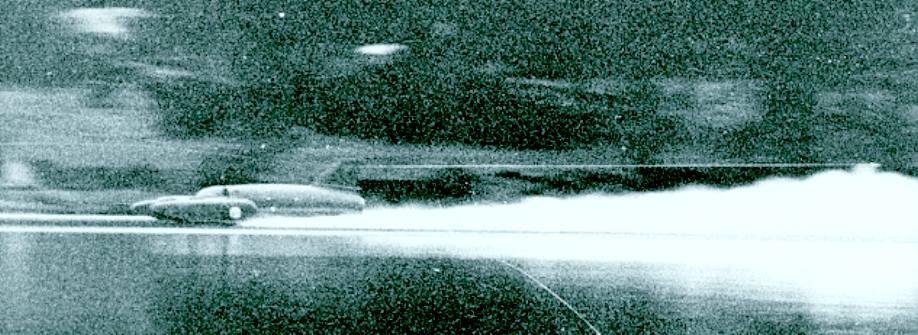
Donald
Campbell doing what he knew
best, attempting to rack up another notch and collect yet more prize money.
He almost became a rocket man in his quest to keep
sponsors interested. Money is simply the power to get things done in a
modern world.
Speaking publicly for the first time, his former brother-in-law Brian Hulme, 88, says Donald believed he was in the throes of a breakdown. During a car journey the pair went on, just before Donald left for Coniston, he asked Brian – who’d been through a breakdown himself – to pull over.
‘He said, “What’s it like having a nervous breakdown?” And I told him… Couldn’t get out, panic stations, it was terrible. And he said, “God, I’m in the middle of one!” If you want my opinion, he shouldn’t have been in that cockpit. Not the man I spoke to.’
There was more pressure on Donald than there ever was on his father. In that
golden age of
record breaking, he had to keep breaking them to attract sponsorship deals. His home movies show him enjoying the jet-set lifestyle. In 1958, he married third wife, cabaret singer
Tonia Bern. She says, ‘When I met him, I melted. Three hours later we were in bed. A few weeks later we were married.’
But his obsession remained. ‘Donald used to frustrate people by saying, “Do you think the old man would be proud?”’, says Bluebird historian Neil Sheppard. ‘Donald should have been proud of himself, forget the old man!’
Desperate for money, as a new generation of Grand Prix winners attracted the sponsors – and as the public, now hooked on the space race while countries raced to the Moon, lost interest – ‘Donald changed. He became an old man,’ Tonia says.
That fatal morning, Donald was in a hurry, but he wasn’t suicidally reckless. ‘He didn’t know what would happen to his career if he didn’t break the record,’ Brian Hulme recalls.
‘So he sat in that boat and went for it.’ On the first run, he averaged 297.6mph but shockingly, Bluebird briefly took flight. Sheppard has
analyzed both runs.
‘Bluebird had almost flipped on the first run and Donald knew it. For about 0.7 seconds, the boat is starting to fly. What nobody could have known was that in excess of 310mph, Bluebird was on a knife-edge.’
Donald turned quickly to make the second run; he had only moments before the agitated wake rippled back from the shore. The boat accelerated to 328mph, bounced three times and became airborne – but Donald’s radio commentary continued.
‘There’s no panic in his voice. He’s fully aware that he’ll die,’ Sheppard explains. ‘Until the last ten seconds of his life, he was convinced he was going to break the 300mph record. He didn’t have a
death wish, but he shouldn’t have had to do it. He held eight speed records but he almost had to prove himself like a beginner.’
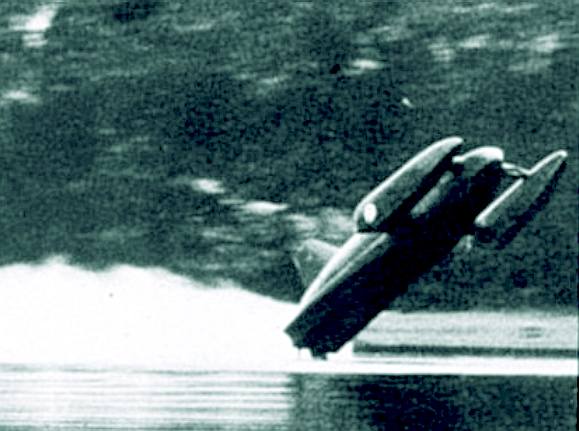
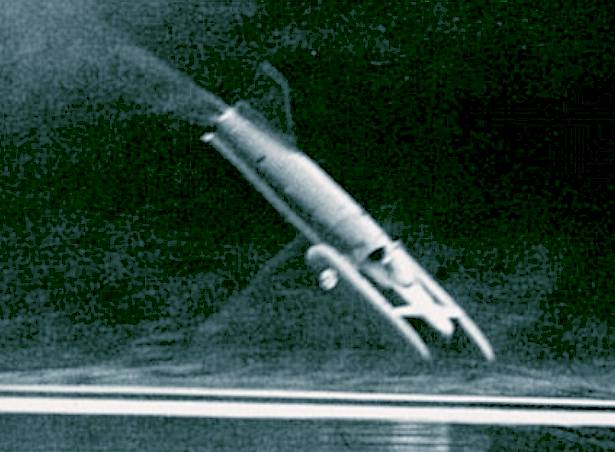
One
of the most famous crash sequences in water speed record history. It is
unfortunate that the media had become relatively complacent, hence the
footage is nowhere near as good as it might have been. On the other
hand, it was a very long course to have to cover with a limited number
of cameras.
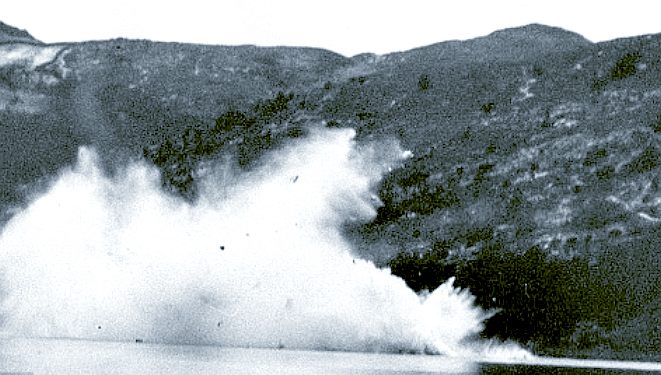
THE
GUARDIAN 26 OCTOBER 2002 - Inquest lays to rest theory of Campbell crash
suicide
The mystery of how world
water speed record holder Donald Campbell died was brought to a conclusion yesterday after more than 35 years, when a coroner decided his death was an accident.
Various theories - including suicide - had been put forward for his death on Coniston Water in January 1967 while trying to take his craft Bluebird above
300mph.
They were quickly discounted by the inquest at John Ruskin School, just a few hundred metres from the Cumbrian lake where he perished.
The hearing took a dramatic turn when one witness, Julian Happian Smith, an expert in crash dynamics, said that Campbell himself had caused the accident, by easing off on the throttle. He based his claim on the contentious words "I am drawing back", contained in The Bluebird Years, written by Campbell's friend, Arthur Knowles.
Campbell's daughter, Gina, was adamant that her father had never said those words in the moments before the crash.
The Furness coroner, Ian Smith, agreed with her, saying there was no evidence before the inquest that Campbell had uttered the words.
Mr Smith said: "Donald Campbell was a courageous man and he knew what he was undertaking was inherently dangerous. I was 17 years old when this happened and saw the crash on
TV.
"He was a hero to me, and my more recent involvement in the story has only consolidated my view of him."
Campbell, 45, had been eager to take Bluebird beyond 300mph. He was in high spirits as he set off in his E-type
Jaguar, cheerily pipping the horn, for the
lake. His team had patiently spent the winter of 1966 holed up at a hotel in Coniston waiting for the right weather and lake conditions.
He wanted to better his record so he could attract publicity and fund his attempt to build a Rocket car.
Bluebird's engine, taken from a jet fighter plane, cut out as he began his attempt, but he managed to restart it and accelerate up to 297mph.
He then turned to make the re-run (necessary for a world record) but did not stop to refuel, despite it being a protocol established on six previous occasions. The wake created by his first attempt had yet to clear as he reached more than 320mph. Dr Happian Smith also suggested - this time, less controversially - that this rough water was also partially to blame.
The craft appeared in some difficulty well before the accident, he told the inquest. At the crash moment Bluebird rose, somersaulted in mid-air, and fell back, striking the water and breaking in two. Mr Campbell was killed instantly, his body receiving multiple fractures. The craft hit with an impact velocity of 185mph, 45 degrees off horizontal and 10 degrees off course, and with its engine cut out.
The wreckage and Campbell's body had lain in the lake 150ft below the surface until spring last year, when it was recovered by divers led by William Smith.
He described how his salvage team recovered loose change, a cigarette lighter engraved with facts and figures of Campbell's previous world records, and a gold St
Christopher engraved: To Donald, from Daddy, November 1940.
The oft-quoted myth that conditions on Coniston Water were like a mirror was finally dispelled yesterday, as was the theory of suicide.
"It does not appear to have been like a mirror on the second run," said Mr Smith. "It was on the first one."
Ms Campbell, 52, said after the inquest: "We always dismissed the suicide theory. Now it has been completely knocked on the head."
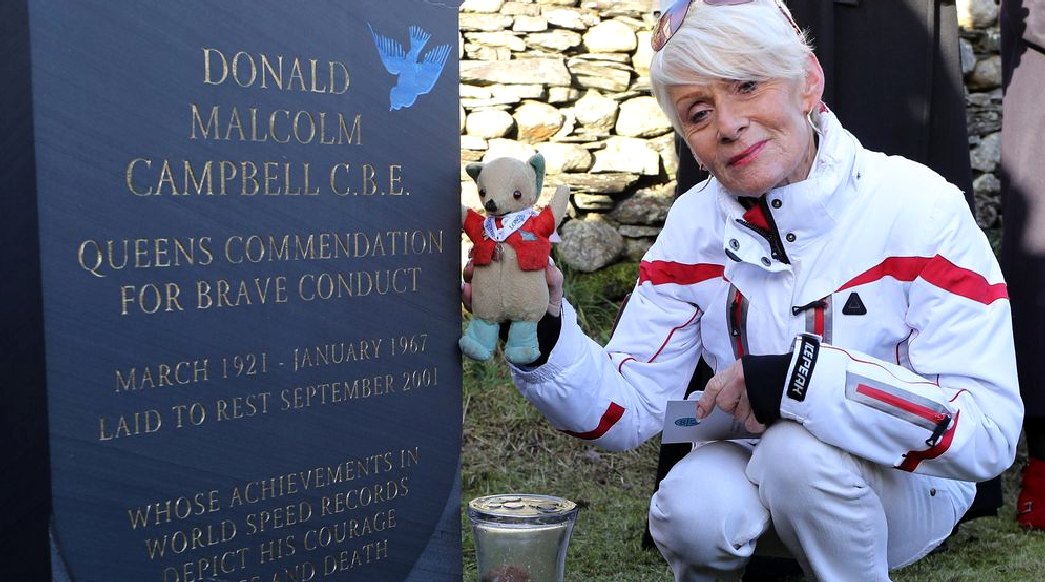
50
YEAR ANNIVERSARY DAILY
MAIL 4 JAN 2017 - According to an article in the Daily
Mail online, the daughter of hero Donald
Campbell who died as he attempted a new water speed record has laid
flowers on Coniston
Water to mark the 50th anniversary of the tragedy.
Gina Campbell, who is the spitting image of her grandfather, visited the
Cumbrian lake on the morning of the 4th of January 2017 to remember her
father, 45, who died
on January 4 1967 when his jet-powered boat, Bluebird K7, flipped into the
air and disintegrated. She was among a small party who traveled by boat
to the site of the crash and laid flowers on the lake at the exact time of
the tragedy.
During the journey she clutched her father's teddy bear
mascot, Mr Whoppit, which was found among the wreckage 34 years later.
Campbell broke eight world speed records on water and on land in the 1950s
and 1960s and remains the only person to set both world land and water
speed records in the same year. He was posthumously awarded the
Queen's Commendation for Brave Conduct.
In his fatal record attempt on the Cumbrian lake, Campbell - the son of
Sir Malcolm Campbell, who himself held land
and water speed records - had set himself a target of reaching 300mph
(480kph). In 2001 Campbell's body - with his race suit intact - and the
wreckage of Bluebird were recovered from the depths of the lake. He was
buried later that year in the village of Coniston.
Speaking at Coniston Water, Ms Campbell is quoted as saying: 'This is
the site of 50 years ago where he met his Waterloo.
'Luckily there is a lot of people that still support his achievements and
it is very humbling for me to be able to be here and represent my family
and pay my own respects to my father.
'It is really hard to describe one's emotions. For me the biggest one is
humility. I am just so proud to be my father's daughter and to have
witnessed what he did in his life, and that people are still following him
here today is fantastic. 'His life lives on through on a lot of other
people's imagination and their own courage.' 'He was with my dad through
all his achievements and through his death so I thought he had better come
along today and relieve the moment.'
'It
was beyond these days of risk assessment and health and safety, and he
went out and he did what he did. He did it most times with huge
success.'
Before
the memorial service began as crowds gathered at the village green, Ms
Campbell is quoted as saying that: "The day had been
'bittersweet'. 'My dad did not do things for public display but I think
he would be delighted to see the public here today.'
Holding her father's teddy bear
mascot, Gina is quoted as saying: 'He survived the accident with my dad.
He has got his life jacket on today because we don't want any more
emotions in the water. After she laid a wreath at her father's
graveside, she spoke of feeling 'pride' at the public recognition of 'a
true hero'. Gina
Campbell had a close call with death herself while piloting a high
speed hydroplane during one of her water speed record attempts. The boat
she was driving flipped over in exactly the same way as the K7 had on
the fateful day. Fortunately, Gina survived the 160 mph incident to race
another day.
A public remembrance service will take place later at his memorial on
the village green before more wreaths are laid at Coniston Cemetery. It
is hoped that Bluebird will be restored by next year and will take to
Coniston Water again before it finds a permanent home in the village's Ruskin
Museum. From an article by Steph
Cockroft
DAILY
MAIL OCTOBER 10 2011
- Donald Campbell was NOT reckless:
Experts say Bluebird simply could not withstand the speed.
A new book has finally laid to rest conspiracy theories surrounding the death of Donald Campbell during a world speed record attempt more than 40 years ago.
Campbell was killed on Coniston Water in Cumbria in January 1967 when his Bluebird K7 flipped over while traveling at speeds of more than 300mph.
The horrific accident has been the subject of fevered speculation ever since.
Some people have suggested that Campbell committed suicide while others have speculated that he may have run into obstacles in the water.
But a new book by author Neil Sheppard - called Donald Campbell, Bluebird and the Final Record Attempt - reveals that the record holder unknowingly pushed the boat beyond its physical limits.
Mr Sheppard, speaking to The Independent on Sunday, said: 'Campbell was not reckless and at no time, until seconds before disaster, did he think he had exceeded Bluebird's safe operating envelope.'
'He knew he was right on the edge, and was quoted as saying this would be his riskiest record attempt to date, but he did not make his return run too soon, he did not run into any obstacle, or materially adverse water conditions, and he certainly did not have a death wish.
'The basic fact is the Bluebird just went too fast. 'No one involved with her engineering was fully aware that the limit was just above the 300mph mark that Campbell was aiming for.'
The author used new material and hundreds of illustrations to carry out a scientific and engineering analysis of the accident.
He teamed up with Dr Keith Mitchell, a retired physicist from the Department of Medical Physics at the Royal Victoria Infirmary in Newcastle.
And the scientist discovered that at speeds of over 310mph, Bluebird K7, which was built in 1954, was only marginally stable.
Mr Campbell's daughter, Gina, told the Independent on Sunday: 'I am so pleased this book puts a stop to all the silly rumours that my father committed suicide or was foolhardy or would do anything stupid.
'It doesn't change the endgame, but it's a big help.'
Campbell began using his father's old boat Bluebird K4, but after a structural failure at 170 mph in 1951 he developed the Bluebird K7.
He first broke the record in 1955 with a speed of 202mph. That rose to 260mph by 1959. By 1966, his record stood at 276mph.
He remains the only person to set both world land and water speed records in the same year in 1964.
In total he set seven world water speed records in K7 between 1955 and 1964.
Bluebird is being painstakingly rebuilt by Bill Smith, an engineer and diver who found the sunken wreck in March 2001.
It will be displayed in the Bluebird Wing of the Ruskin Museum in Coniston when it is completed in 2012 or 2013.
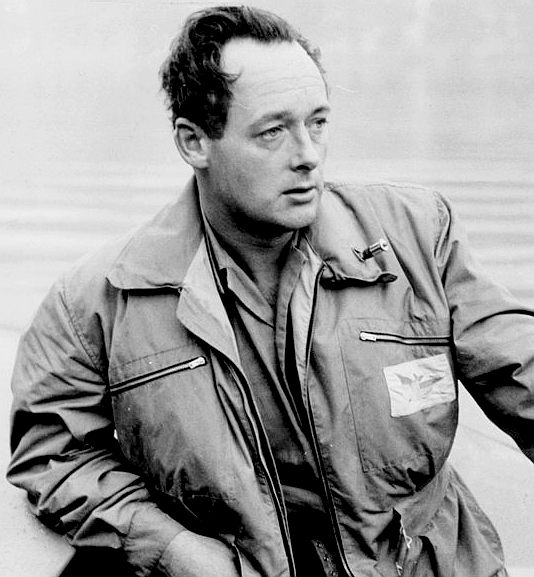
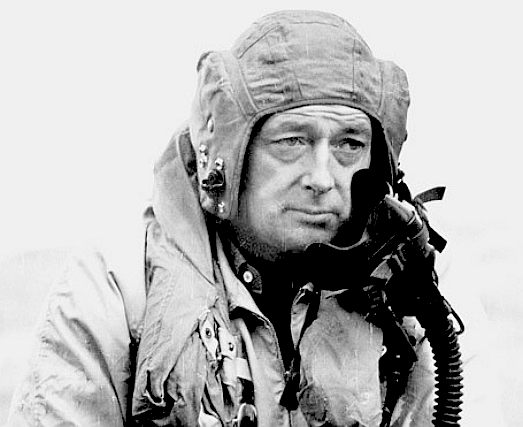
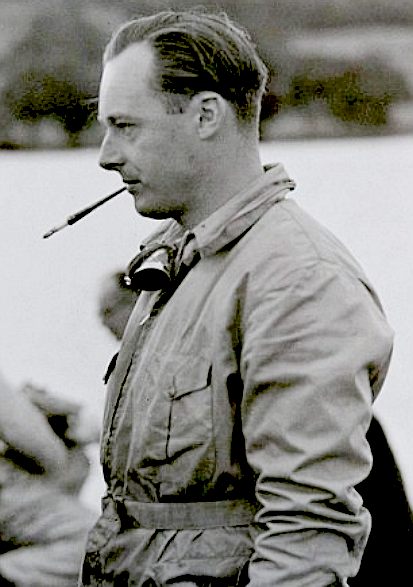
Donald
Campbell in reflection
BBC
NEWS 25
OCTOBER 2002 - Donald Campbell death was accident
Speed legend Donald Campbell died accidentally as he attempted to beat his own water speed record in the Lake District in 1967, a coroner has ruled.
An inquest in Coniston, Cumbria, heard that one of the reasons for Campbell's Bluebird boat flipping spectacularly in the air was that the water was still ruffled from his first run just moments earlier.
Furness coroner Ian Smith said many theories had been suggested including suicide, which he ruled out.
Surrey-born Campbell was 45 when he attempted to beat his world record of 267mph on Coniston Water, Cumbria on 4 January, 1967.
Dramatic television footage has shown his Bluebird K7 jetboat rise 30ft into the air and somersault across the water for almost 100 yards, killing Campbell instantly.
Mr Smith said many theories surrounded the reason why Campbell's boat left the water.
One of the theories was that Bluebird hit a submerged or partially submerged object.
Mr Smith said: "There is not a scrap of evidence to that effect. I am happy to dismiss that theory completely."
Another theory was that Bluebird ran out of fuel, causing the vessel's nose to lift.
Mr Smith said evidence by accident investigator Dr Julian Happian Smith dismissed that theory.
The coroner said that the boat contained a maximum of 48 gallons and although Campbell did not refuel after his first run, there would still have been 17 gallons of fuel on board.
Mr Smith added: "I do not think he ran out of fuel."
The coroner also dismissed the theories that icing on the front of the engine and engine failure caused Bluebird to crash.
Mr Smith said he had to touch on the delicate subject that Campbell committed suicide because of the whispers surrounding the theory.
He said Campbell was a publicist's dream, who was good looking, charming, and would have been able to cash in on his amazing success. And there was no reason for him to kill himself.
He said: "I have no doubt whatsoever, this was not suicide."
Mr Smith, said he hoped that would quash the untrue theory.
The coroner said one of the reasons Bluebird left the water was the safety margin in which the boat operated.
He said its front could only lift 6 degrees above the level of the water if it was travelling in ideal conditions at 300 mph
He said: "If the front moves more than six degrees off that level, then it is likely to become airborne."
Campbell was probably travelling in excess of 320mph, which narrows the margin of safety to below six degrees, he added.
UNEVEN SURFACE
He said: "The lake was not an absolutely smooth, mirrored surface.
"But any slight ripple, however it was caused, by the wind or any other way, will have some effect on the stability of the boat."
He said the wake from Campbell's first run may also have caused the rippling of the water, adding another factor into the equation and the reason behind Bluebird going airborne.
It was likely Bluebird left the water because it was unbalanced due to factors which included the uneven water surface and the speed at which Campbell was travelling, the coroner said.
Mr Campbell's daughter Gina, 52, averted her gaze as the film of the Bluebird's first run and the second, fatal, return run, was shown on a television in the courtroom.
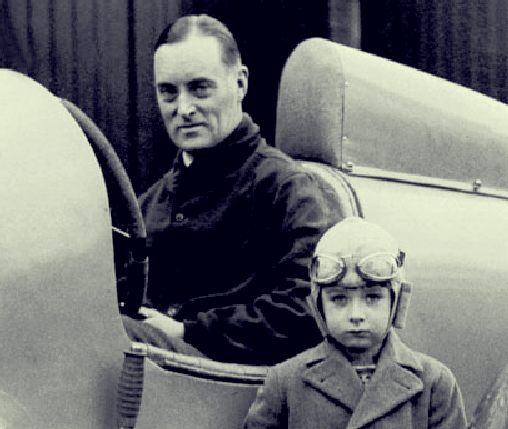
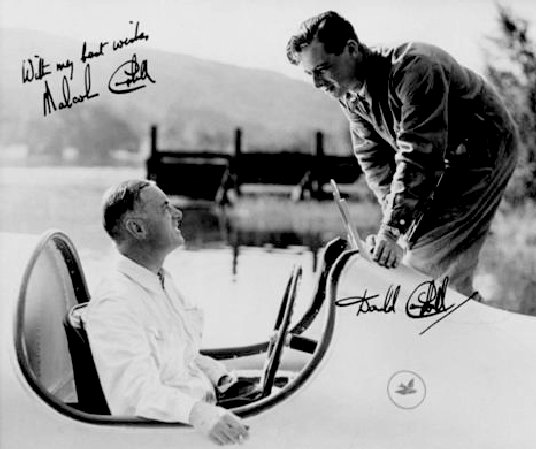
Father
and son pictured with a early Bluebird LSR vehicle (left) and getting a
taste for boating (right), young Donald visibly
inspired by his famous father, as you may imagine from the goggles he is
wearing - carried on with his love of helmets, and support from Tonia
Bern and much of Australia,
where he was better received.
DAILY
EXPRESS OCTOBER 11 2011 - Donald Campbell would detest our risk averse world
The last words of a man who must have known he was facing certain death: "I'm getting a lot of bloody row in here. I can’t see anything. I’ve got the bows out. I’m going...”
In recent years it has become fashionable to portray Donald Campbell, as his boat Bluebird K7 lifted out of the water while attempting to break his own water speed record on Coniston Water on January 4, 1967, as foolish and reckless if not actually insane.
There are various theories that he was undergoing a mental breakdown, that he was consumed by his own superstitions after drawing an unlucky hand at cards the previous day, that his last record attempt was really an act of suicide.
That is not how it appeared at the time. Just 24 days after his death Campbell was awarded the Queen’s Commendation for Brave Conduct “for courage and determination in attacking the world speed record”.
It is not how Campbell’s biographer Neil Sheppard sees it either. In a new book Donald Campbell, Bluebird And The Final Record Attempt he concludes that Campbell died simply because he and his engineering team were unaware of how close they were pushing the boat to its limits.
Unknown to Campbell and his engineers there was no way anyone could have taken the boat to 315mph – Bluebird’s speed as it lifted out of the water – and survived.
BY TODAY’S standards that qualifies as the height of recklessness. Who now would venture out in a boat at 315mph without first testing a
computer simulation of the craft?
But in 1967 the computing power available was minuscule compared with that of today. If you wanted to break a speed record you had to take a chance with your life.
We too easily assume that Campbell must have had a death wish because in our pampered, risk-averse society we no longer understand the physical dangers which pioneers had to face in order to push back the boundaries of human achievement.
It wasn’t just the water speed record it was just about every form of engineering.
When we get on a plane for our holidays we take it for granted that we will survive and in the incredibly unlikely event that we don’t we expect that our heirs will sue the airline for gross negligence.
That is not unreasonable – air travel has become extremely safe and there is no excuse for an airline to cut corners.
But we should never forget that it would not have been possible for air travel to exist at all had it not been for reckless Edwardian gentlemen taking gambles with their lives – gambles which they often lost.
If we do not take risks we do not learn. The biggest tragedy will be if we become so averse to danger that progress comes to a halt. Maybe we are already close to that stage.
The most remarkable thing about Campbell’s fatal last voyage was that he so very nearly established a record that could have stood to this day.
Campbell’s record attempt was declared null and void because he failed – by just 200 metres – to reach the end of the measured kilometre. Yet 44 years later the world water speed record at 317mph is just 2mph higher than his last measured speed.
And even that record, established by Australian Ken Warby, is 33 years old.
There is a team at Salford University – Quicksilver – which is designing a boat to break this record but a planned attempt on Coniston Water in 2009 failed to materialise. The lake is now subject to a speed limit of 10 knots, which the Lake District National Park Authority has said it will temporarily lift for a genuine record attempt.
But Quicksilver’s website goes through endless procedures which must be carried out before getting permission. It says it has undertaken “some preliminary environmental protection studies” and consulted with numerous bodies including the
National Trust and Coniston parish council. And it doesn’t suggest it has even got as far as approaching the local authority’s ’elf & safety team.
One feels that Campbell would probably by now have packed up and gone home, not frightened by the prospect of death but crushed by modern
bureaucracy.
IT IS perhaps only thanks to the memory of Campbell that the authorities are prepared even to consider new water speed record attempts in the Lake District. Not that there are many record speed attempts going on elsewhere in the world. Quietly, mankind seems to have stopped breaking speed records and pushing other boundaries.
The land speed record – set by British driver Andy Green in Utah – is 14 years old.
Supersonic passenger air travel – which arrived with Concorde’s first commercial flight in 1976 – is now part of aviation history.
It is 39 years since a man last stood on the Moon. The idea of putting a man on Mars, to which Nasa committed itself in the late Sixties, now seems a pipe dream. Even if the US government was prepared to spend the money it is questionable whether Nasa would consider launching someone on such a dangerous mission.
This is not the attitude on which great civilisations are built. The footage of Donald Campbell’s last mission – delivered in clipped tones on British Movietone News – stands out as a relic from a more adventurous and more ambitious age.
We should be impressed by him rather than think he was driven by a death wish.
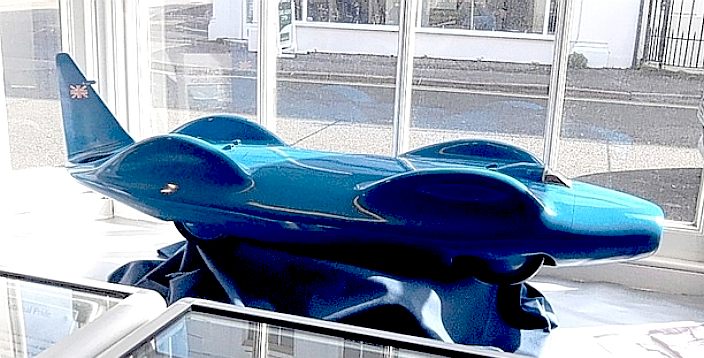
APRIL
2014 - An exhibition at the Museum in Leatherhead featured a model of the
CN7 Bluebird, on loan from Brooklands.
WHAT
IS A NERVOUS BREAKDOWN
Many people classify a nervous breakdown as a “mental
breakdown” and the two are linked. A nervous breakdown is a subtype of mental breakdown that involves intense feelings of anxiety and stress – this is what causes us to react with our “nerves” and we feel “nervous.”
A nervous breakdown is typically caused by excessive activation of the sympathetic nervous
system - as for example when under intense pressure to achieve a speed
record. This triggers a “fight or flight” response in the body and results in intense feelings of anxiety and tension.
The anxiety becomes so overwhelming that the subject is unable to cope with life.
During this experience, you may feel as though life is completely hopeless and that you will never recover or return to normal. It can be
difficult to cope with these symptoms because your body is either in a state of
hyper-arousal or is transitioning into one. You may feel as if you are going crazy and may experience rapid thinking, feel depressed, and suicidal. Your outlook on the future may seem
bleak and things may feel as if they are never going to be the same.
The good news is that many people have experienced nervous breakdowns to a very severe degree and have made full recoveries back to
bio-psychosocial homeostasis.
A nervous breakdown is somewhat proportionate to the build-up or onset length of the symptoms.
That Donald Campbell was under extreme financial pressure as one of the
reasons for chasing his own tail (records) is another factor that
suggests that DC could very well have been entertaining suicidal
thoughts. In such a mental
state, he may well have thrown caution to the wind in pushing the K7
that but harder than a rational man have thought prudent.
On
that basis, you may come to the irresistible conclusion that Donald
Campbell took his own life, or you may be more gracious and agree that a
reckless hand on a jet engine throttle leads to a very rare method of
ending it all - from which there is no turning back. Indeed, when Donald
tried to pull back, that was his very undoing.
DC's
HISTORY
Date
and Place of Birth: 23rd March 1921,
Povey Cross, Horley, Surrey, England.
Education:
School at Horsham, then St. Peter's School, Seaford then to Uppingham
Public School, Rutland. (The same as his father).
Death: 4th January 1967, Died in accident during a speed record attempt in Bluebird on Coniston Water, Cumbria, England whilst exceeding 300 mph Age at Death 45.
Site of Grave: Bluebird boat and body found and retrieved in May 2001. Remains finally buried in St. Andrew’s Church, Coniston, Cumbria, 12th September 2001. Memorial in Coniston, Cumbria, England.
MARRIAGES
1.
Daphne Harvey, 1945, Caxton Hall Registry Office, London under special
Licence as Daphne's parents
had forbidden Donald to marry her.
2. Dorothy McKegg.
3. Tonia
Bern 1958 24th December 1958, Caxton Hall, Registry Office, London.
SIR
MALCOLM CAMPBELL'S BLUE BIRDS
Sunbeam
Napier
Lion
Rolls
Royce
K3
K4
DONALD
CAMPBELL'S BLUEBIRDS
K7
CN7
CNM8
JETSTAR
LINKS
Daily
Express Donald Campbell would detest our risk averse world
BBC
News Donald Campbell inquest and coroner's verdict
Daily
Mail Donald Campbell acting recklessly Bluebird crashed
The
Guardian Donald Campbell Inquest 2002 Helen Carter
http://www.theguardian.com/uk/2002/oct/26/helencarter
Daily
Mail Was Donald Campbell driven by a terrifying death wish
Daily
Record Scotland unseen photographs of Donald Campbells Bluebird CN7
Donald-Campbell-plundered-daughters-trust-fund-to-finance-lavish-lifestyle-memoirs-claim
http://www.dailymail.co.uk/femail/article-2009828/Was-Donald-Campbell-driven-terrifying-death-wish.html
http://www.dailyrecord.co.uk/news/scottish-news/pictures-unseen-photos-donald-campbells-3814300
http://www.dailymail.co.uk/sciencetech/article-2047038/Donald-Campbell-acting-recklessly-Bluebird-crashed.html
http://www.express.co.uk/comment/expresscomment/276681/Donald-Campbell-would-detest-our-risk-averse-world
Don-and-me-kent-mans-story
http://www.gregwapling.com/hotrod/land-speed-racing-australia/land-speed-racing-australia-donald-campbell.html
Greg
Wapling land speed racing Australia Donald Campbell
http://www.kentonline.co.uk/kent-business/county-news/don-and-me-kent-mans-story-of--a85671/
Steve
Hogarth's account of the raising of the Bluebird
http://en.wikipedia.org/wiki/Suicide
http://www.nationaltrust.org.uk/
http://www.english-heritage.org.uk/
http://news.bbc.co.uk/1/hi/england/2359313.stm

LEGENDARY
DESIGN - The
blue bird
legend goes on. The
classic lines of the stunning BE3 electric racing
car were inspired
by Reid Railton and his designs for the
Napier Lion and
Rolls Royce
engined Blue Bird LSR cars in the 1930s. The Blueplanet BE3
features instant battery recharging using the patent
Bluebird™ cartridge exchange system under license from BMS.
This high performance WLSR car is also solar assisted. She is designed for speeds in excess of
350mph across a flying mile using clean electricity. It is unlikely that a
member of the Campbell family will pilot her, where so many good Formula 1
and Formula E drivers have more competition skills. Imagine the spectacle of this beautiful
vehicle speeding across the salt at Bonneville,
or flying past on the sand on the Daytona
or Pendine
beaches. The BE3 is available for event
hire, drive-by and the like on 6
months notice, or 3 months notice at increased cost.
|













